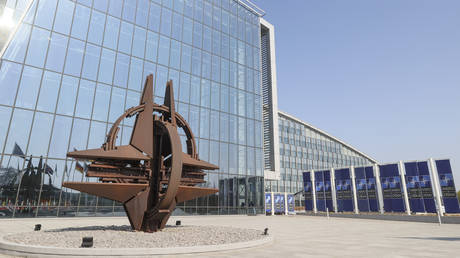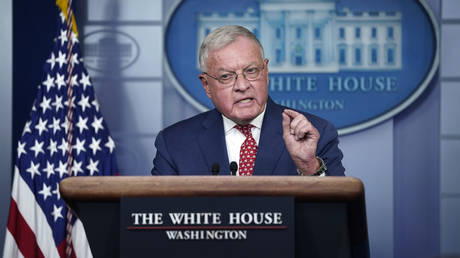ARTICLE AD BOX
SEX slaves, no phones, and armed men at home are just a glimpse into the terror life of the woman married to the leader of ISIS.
Umm Hudaifa, Abu Bakr al-Baghdadi‘s first wife, gave chilling details of their disturbed marriage as her terrorist husband led a ruthless reign over large parts of Syria and Iraq.
 Turkish government media office
Turkish government media office AFP
AFP Evolving from al-Qaeda in Iraq, ISIS grew under Abu Bakr al-Baghdadi
Evolving from al-Qaeda in Iraq, ISIS grew under Abu Bakr al-BaghdadiNow a widow of the ISIS commander, Hudaifa is currently being held in an Iraqi jail as she is probed for terrorism-related offences.
Speaking from prison, the terror bride claimed how al-Baghdadi was psychologically damaged and allegedly sexually tortured in prison.
She went on to claim that the terror boss even married off his own 12-year-old daughter to one of his friends.
Not to mention keeping sex slaves at their family home.
Umm Hudaifa perfectly recalled the day the jihadi leader declared the caliphate.
The couple was living in Raqqa, IS’s Syrian stronghold, in the summer of 2014.
As the sought head of the radical jihadist group, Abu Bakr al-Baghdadi frequently spent time in different areas, and on one of these times, he sent a guard to the residence to take up two of their young sons.
Hudaifa told the BBC: “He told me they were going on a trip to teach the boys how to swim.”
She claims she was cut off from the outside world, and he had not allowed her to watch television or use any other technology, such as mobile phones, since 2007.
So when alone, she would watch the television in secret as al-Baghdadi was unaware it wasn’t broken.
 Members of Wilayat Khurasan – Islamic State’s affiliate group in Afghanistan – about to murder ten men in eastern Afghanistan’s Kot district
Members of Wilayat Khurasan – Islamic State’s affiliate group in Afghanistan – about to murder ten men in eastern Afghanistan’s Kot district Hudaifa claimed she also met ISIS Hostage Kayla Mueller
Hudaifa claimed she also met ISIS Hostage Kayla MuellerAssuming her husband was away with her boys, she turned on the TV, to immediately be faced with a “huge surprise”.
She witnessed her husband giving a speech at the Great Mosque of al-Nuri in Mosul, northern Iraq, introducing himself as the leader of the newly established Islamic caliphate.
Only a few weeks had passed since his fighters had taken over the region.
The world-infamous video showed al-Baghdadi making his first appearance in public in years, sporting a long beard, black robes, and a demand for Muslim allegiance.
It was a pivotal moment for ISIS as it stormed over Syria and Iraq.
Hudaifa claims she was taken aback to discover her sons were not learning to swim in the Euphrates but were instead in Mosul with the terrorist leader.
Born in 1976 into a conservative Iraqi family, Umm Hudaifa married Ibrahim Awad al-Badri in 1999, who would later known by the pseudonym Abu Bakr al-Baghdadi.
She claims that after completing his studies of Sharia, or Islamic law, at the University of Baghdad, he was “religious but not extremist… conservative but open minded.”
Then, in 2004, a year after the US-led invasion of Iraq, al-Baghdadi was captured by US forces and held for around a year in the detention facility at Camp Bucca in the south.
She says he changed in the years following his release, becoming “short tempered and prone to outbursts of anger.”
Others who knew al-Baghdadi claim that he had ties to al-Qaeda prior to his time in Bucca, but for her, that was the moment when he started to become more radical.
Hudaifa said al-Baghdadi began to “suffer from psychological problems”, and when questioned why, her husband allegedly revealed he was “exposed to something that ‘you cannot understand'”.
He may not have stated it out loud, but in her opinion, “during his detention he was subjected to sexual torture.”
Images that year from Abu Ghraib, another US-run jail in Iraq, surfaced showing inmates coerced into simulating sex acts and adopting degrading positions.
He [al-Baghdadi] told me they were going on a trip to teach the boys how to swim
Umm HudaifaShe talks about how her husband took on a second wife, they frequently moved, and they assumed false identities.
Hudaifa claims that although she requested a divorce, she stayed with him because she refused to comply with his demand that she give up their kids.
She claims that when she attempted to flee, armed men at a checkpoint sent her back to the residence instead of allowing her to pass.
Soon after that, al-Baghdadi wed their 12-year-old daughter Umaima to Mansour, a friend who was given charge of managing the family’s finances.
Umm Hudaifa claims she made an effort to stop it but was ignored.
Nasiba, Umm Hudaifa’s second daughter, was born in August 2014 with a congenital heart abnormality.
Her birth was around the same time Mansour brought nine Yazidi women and girls to the house. They were nine to thirty years old.
In January 2015, Hudaifa also briefly met her husband’s “hostage bride” – kidnapped US aid worker, Kayla Mueller, who was held hostage for 18 months and died in captivity.
These were only a small portion of the hundreds of Yazidi women and children whom ISIS had taken in as slaves as thousands more had perished.
Umm Hudaifa said she was taken aback and “felt ashamed”.
The terror widow denied she was ever involved in any of ISIS’ brutal activities.
But a court case brought by Yazidis who were abducted and raped by members of ISIS have accused her of colluding in the sexual enslavement of kidnapped girls and women.
ISIS takeover of Iraq & Syria in 2014-17

THE ISIS (Islamic State of Iraq and Syria) takeover of Iraq and Syria from 2014 to 2017 involved rapid territorial gains, brutal governance, and significant global impact.
Evolving from al-Qaeda in Iraq, ISIS grew under Abu Bakr al-Baghdadi, exploiting the chaos of the Syrian Civil War to seize large territories.
In June 2014, ISIS captured Mosul, Iraq’s second-largest city, gaining significant resources.
Shortly after, ISIS declared a caliphate with Baghdadi as caliph, controlling major parts of Syria and Iraq, including Raqqa and Mosul.
The group established a strict governance system and used social media for recruitment and propaganda, showcasing its military successes and brutal acts.
Known for extreme violence, ISIS conducted mass executions and terror attacks, including the 2015 Paris and 2016 Brussels attacks.
An international coalition, including the US and local forces, launched a military campaign against ISIS, leading to key victories like the liberation of Mosul and Raqqa in 2017.
By the end of 2017, ISIS had lost most of its territory, though it retained some capacity for insurgent attacks.
The conflict caused massive displacement and humanitarian crises, with cities like Mosul and Raqqa heavily damaged.
Despite being weakened, ISIS continues to pose a threat through insurgent activities and lone-wolf attacks globally.
This period saw intense conflict, international efforts to combat ISIS, and significant impacts on regional stability and global security.
.png)
 5 months ago
6
5 months ago
6








 English (US)
English (US)